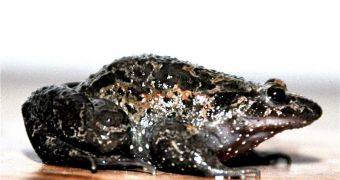In 1996, the International Union for Conservation of Nature (IUCN) announced that, according to information available at that time, Israel's Hula painted frog was an extinct species.
This was the first time when an amphibian was declared extinct by the IUCN.
Fast forward several years, and the IUCN finds itself having to reconsider its decision to list the Hula painted frog as extinct.
This is because this frog species has recently been rediscovered in Israel's northern regions.
Nature informs us that a representative of this species was discovered by an international team of researchers back in October 2011. This specimen was spotted in Israel's Hula Nature Reserve.
As the months went by, several other Hula painted frogs were found.
Sarig Gafny, a researcher working with the Rupping Academic Center in Michmoret, Israel, commented on the rediscovery of this frog species as follows:
“I hope it will be a conservation success story. We don’t know anything about their natural history and we have to study them. The more we know, the more we can protect them.”
What is interesting is that, apart from its being taken off the list of extinct species, Israel's Hula painted frog also got reclassified.
Thus, specialists say that this species of amphibians is a so-called living fossil.
What they mean is that it is the sole survivor of a genus that roamed the Earth millions of years ago and whose other members have only been documented with the help of fossil evidence.
They reached this conclusion after sequencing and analyzing the frog's DNA.
“We provide evidence that not only has this species survived undetected in its type locality for almost 60 years but also that it is a surviving member of an otherwise extinct genus of alytid frogs, Latonia, known only as fossils from Oligocene to Pleistocene in Europe.”
“The survival of this living fossil is a striking example of resilience to severe habitat degradation during the past century by an amphibian,” reads the Abstract for the paper detailing the rediscovery of this species.
The researchers who found that this species had not in fact gone extinct say that such stories bring new hope to those now trying to safeguard our planet's remaining biodiversity.

 14 DAY TRIAL //
14 DAY TRIAL //